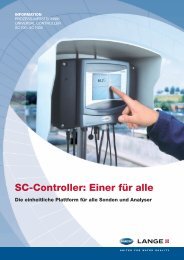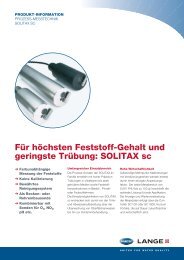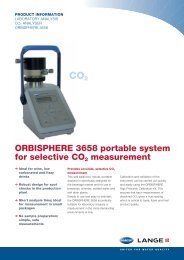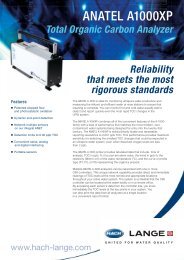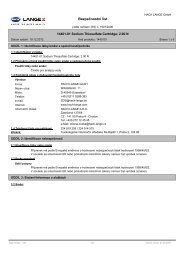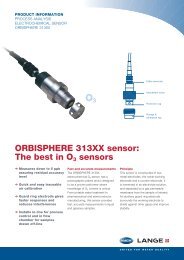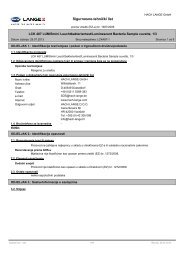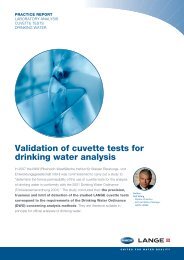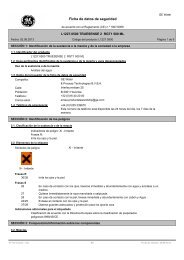Nitrogen parameters: Nitrification, Denitrification - HACH LANGE
Nitrogen parameters: Nitrification, Denitrification - HACH LANGE
Nitrogen parameters: Nitrification, Denitrification - HACH LANGE
Create successful ePaper yourself
Turn your PDF publications into a flip-book with our unique Google optimized e-Paper software.
PRACTICE REPORT<br />
LABORATORY ANALYSIS & PROCESS ANALYSIS<br />
NUTRIENTS<br />
NITROGEN COMPOUNDS<br />
Total nitrogen<br />
(TN)<br />
Organic<br />
nitrogen<br />
(N org )<br />
Ammonium<br />
nitrogen<br />
(NH 4 -N)<br />
Nitrate<br />
nitrogen<br />
(NO 3 -N)<br />
Total<br />
Kjeldahl<br />
nitrogen<br />
(TKN)<br />
Total<br />
inorganic<br />
nitrogen<br />
(N inorg )<br />
Nitrite<br />
nitrogen<br />
(NO 2 -N)<br />
<strong>Nitrogen</strong> <strong>parameters</strong>:<br />
<strong>Nitrification</strong>, <strong>Denitrification</strong><br />
The elimination of nitrogen compounds is a fundamental aspect<br />
of wastewater treatment. <strong>Nitrification</strong> and denitrification have to be<br />
controlled as efficiently as possible to ensure that outflow concentrations<br />
comply with the legal requirements. This is where analysis comes in, as<br />
enduringly stable and cost-effective plant operation depends on targeted<br />
and comprehensive measurements of the individual N <strong>parameters</strong>. The<br />
best results are obtained using a combination of laboratory analysis<br />
(cuvette tests) and process measurement technology (online sensors)<br />
at suitable measurement locations in and at the end of the wastewater<br />
treatment process.<br />
Author:<br />
Petra Pütz<br />
- “Diplom-Ingenieur”, chemistry<br />
- <strong>HACH</strong> <strong>LANGE</strong> applications<br />
laboratory products
2<br />
NITROGEN_BACKGROUND<br />
Wastewater treatment:<br />
elimination of nitrogen<br />
Fig. 1: Ideal for balancing and outflow<br />
monitoring – LATON cuvette tests for the<br />
determination of total nitrogen (TN)<br />
Fig. 2: Spectrophotometer for the<br />
precise evaluation of <strong>LANGE</strong> cuvette tests,<br />
e.g. for nitrogen analysis<br />
Legislative background<br />
<strong>Nitrogen</strong> compounds have a variety of<br />
effects on surface waters:<br />
N org – strongly oxygen depleting<br />
NH 4 + – oxygen depleting;<br />
bei pH > 8, toxic to fish<br />
NO 3 - – eutrophying<br />
NO 2 - – highly toxic to fish<br />
Legislators have therefore defined limit<br />
values for nitrogen compounds in wastewater<br />
discharges to surface waters.<br />
According to the EU Directive concerning<br />
urban waste water treatment<br />
(91/271/EEC), the total nitrogen (TN) in<br />
the outflow of a sewage treatment plant<br />
must not exceed a limit value of 15 mg/L<br />
or 10 mg/L (depending on the size of the<br />
plant), or must be at least 70–80 % lower<br />
than the concentration in the plant<br />
inflow. Most Member States impose<br />
additional requirements. In Germany, for<br />
example, the General Administrative<br />
Framework Regulation on Wastewater<br />
[Abwasserverordnung] specifies minimum<br />
requirements for NH 4 -N and N inorg .<br />
Moreover, the total nitrogen in inorganic<br />
compounds is used to determine wastewater<br />
charges.<br />
<strong>Nitrogen</strong> elimination<br />
<strong>Nitrogen</strong> in the inflow of a municipal sewage<br />
treatment plant is largely present as<br />
organic ammonium (urea, proteins, etc.)<br />
and ammonium nitrogen. The exact<br />
relationship of the two <strong>parameters</strong> to<br />
each other depends on various factors,<br />
including the length of the sewage network,<br />
which is where the conversion of<br />
N org to NH 4 -N begins. The process of<br />
ammonification continues in the sewage<br />
treatment plant, so that most of the<br />
nitrogen in the inflow to the aeration tank<br />
is in the form of NH 4 -N.<br />
<strong>Nitrification</strong><br />
During the biological wastewater treatment<br />
stage, NH 4 -N is converted with the help<br />
of added oxygen to NO 2 -N and then<br />
NO 3 -N. The microorganisms responsible<br />
for nitrification (Nitrosomonas and Nitrobacter)<br />
are, however, extremely sensitive.<br />
They require constant temperatures of<br />
not less than 12 °C, together with a<br />
favourable C:N:P ratio and an adequate<br />
supply of added oxygen. The sludge age<br />
should be adjusted to the slow multiplication<br />
of the nitrifying bacteria. If the nitrification<br />
process breaks down,<br />
Fig. 3: NITRATAX sc for continuous monitoring<br />
of nitrate nitrogen and for controlling the<br />
nitrification process<br />
<strong>Nitrification</strong> (aerobic)<br />
Organic N compounds<br />
(urea, proteins, etc.)<br />
Hydrolysis and<br />
ammonification<br />
Ammonium nitrogen NH 4 -N<br />
Nitrite nitrogen NO 2 -N<br />
Nitrate nitrogen NO 3 -N<br />
Nitrosomonas<br />
+ oxygen<br />
Nitrobacter<br />
+ oxygen<br />
<strong>Denitrification</strong> (anaerobic)<br />
Nitrate nitrogen NO 3 -N<br />
Nitrite nitrogen NO 2 -N<br />
NO, N 2 O<br />
Elementary nitrogen N 2 <br />
Nitrate reductase<br />
- oxygen<br />
Nitrite reductase<br />
- oxygen<br />
NO reductase, N 2 O<br />
reductase - oxygen<br />
Fig. 4: Degradation processes associated with nitrogen elimination<br />
www.hach-lange.com
3<br />
Table 1: Overview of individual nitrogen <strong>parameters</strong> and determination options<br />
N compounds Formula Sample preparation Cuvette tests Process instruments Measurement points, relevance<br />
Organic nitrogen N org Homogenisation,<br />
digestion<br />
Sewage treatment plant inflow; conversion<br />
to NH 4 -N during the course of the<br />
wastewater treatment<br />
Ammonium nitrogen NH 4 -N Filtration LCK302<br />
LCK303<br />
LCK304<br />
LCK305<br />
Nitrate nitrogen NO 3 -N Filtration LCK339<br />
LCK340<br />
Nitrite nitrification NO 2 -N Filtration LCK341<br />
LCK342<br />
LCK541<br />
Inorganic nitrogen<br />
(= NH 4 -N + NO 3 -N +<br />
NO 2 -N)<br />
Kjeldahl nitrogen<br />
= N org + NH 4 -N<br />
Total nitrogen<br />
(= N org + NH 4 -N +<br />
NO 3 -N + NO 2 -N)<br />
N inorg<br />
(in the legislation<br />
often confusingly<br />
referred to as N total )<br />
TKN<br />
TN<br />
Filtration<br />
Homogenisation,<br />
digestion<br />
Homogenisation,<br />
digestion<br />
LCK302/303/<br />
304/305 +<br />
LCK339/340 +<br />
LCK341/342/541<br />
LCK138<br />
LCK238<br />
LCK338<br />
AISE sc<br />
AN-ISE sc<br />
AMTAX sc<br />
NISE sc<br />
AN-ISE sc<br />
NITRATAX sc<br />
Sewage treatment plant inflow, aeration,<br />
sewage treatment plant outflow; control<br />
of nitrification/denitrification, monitoring<br />
of limit values<br />
Aeration, sewage treatment plant outflow;<br />
control of nitrification/denitrification,<br />
monitoring of limit values<br />
Aeration, sewage treatment plant outflow;<br />
relatively unstable intermediate product of<br />
nitrification/denitrification, monitoring of<br />
limit values<br />
Sewage treatment plant outflow;<br />
monitoring of limit values, relevant<br />
parameter for wastewater charges<br />
Sewage treatment plant inflow; balancing<br />
Sewage treatment plant inflow, sewage<br />
treatment plant outflow; balancing, limit<br />
value monitoring in accordance with EU<br />
directive<br />
Important: In wastewater analysis, concentrations are always expressed in terms of the N content! The results are therefore shown as xx N<br />
(conversion factors: NH 4 -N × 1.3 = NH 4 + / NO 3 -N × 4.4 = NO 3 - / NO 2 -N × 3.3 = NO 2 - ).<br />
several days may be elapse before it<br />
stabilises again.<br />
<strong>Denitrification</strong><br />
Under anoxic conditions, NO 3 -N is converted<br />
to elementary nitrogen via the<br />
intermediate products NO 2 -N and<br />
NO/N 2 O. <strong>Denitrification</strong> is carried out<br />
either before (upstream), during (simultaneous)<br />
or after (downstream, rare) the<br />
biological treatment stage.<br />
The presence of sufficient readily biodegradable<br />
carbon is important for this<br />
process. No dissolved oxygen must be<br />
present.<br />
Literature<br />
- <strong>HACH</strong> <strong>LANGE</strong> Practice Report “The<br />
right process measurement technology<br />
for N and P degradation”, February<br />
2008.<br />
- <strong>HACH</strong> <strong>LANGE</strong> Practice Report “Optimal<br />
nutrient ratios for wastewater treatment”,<br />
March 2008<br />
- EU directive of 21 May 1991 concerning<br />
urban waste water treatment<br />
(91/271/EEC)<br />
Fig. 5: Ion-selective sc probe with innovative<br />
CARTRICAL technology for stable, continuous<br />
monitoring of ammonium nitrogen content.
NITROGEN_WASTEWATER ANALYSIS<br />
N elimination: optimal operational<br />
reliability through optimal analysis<br />
Only regular, targeted measurements of<br />
the individual nitrogen <strong>parameters</strong> make<br />
lastingly functional and therefore costeffective<br />
nitrogen elimination possible:<br />
Online with process sensors<br />
(NH 4 -N, NO 3 -N) and in the laboratory<br />
with the <strong>LANGE</strong> cuvette test<br />
system (NH 4 -N, NO 3 -N, NO 2 -N, TN).<br />
Changes to the plant or variations in<br />
the inflow make even closer monitoring<br />
necessary, as the microorganisms adjust<br />
only slowly to the new conditions. This is<br />
especially true of the sensitive nitrifying<br />
bacteria. A number of days may pass<br />
before the biological system adjusts to<br />
the changes and maximum biodegradation<br />
efficiency is restored. The same<br />
applies when an incident that impairs the<br />
biological system occurs (e.g. an extreme<br />
inflow peak or an inflow of toxic substances).<br />
Extreme inflow peaks can flush<br />
microorganisms out of the aeration tank,<br />
to the long-term detriment of the nitrification<br />
process.<br />
Stable and reliable limit values in the outflow<br />
are best achieved by maintaining<br />
uniform loading of the biological system.<br />
An exact (analytical) assessment of the<br />
individual nitrogen degradation processes<br />
is therefore necessary, to ensure that any<br />
undesirable influences deriving from the<br />
sewage network, the plant load or the<br />
plant procedures are quickly detected.<br />
Immediate counter-measures can then<br />
be initiated before the biological processes<br />
are seriously disrupted.<br />
Typical measurement locations for<br />
the nitrogen <strong>parameters</strong><br />
Sewage treatment plant inflow: TN<br />
Inflow to aeration tank: TN, TKN, NH 4 -N<br />
Outflow from denitrification stage:<br />
NH 4 -N<br />
Outflow from nitrification stage:<br />
NO 3 -N, NO 2 -N<br />
Sewage treatment plant outflow: TN,<br />
N inorg (NH 4 -N + NO 3 -N + NO 2 -N), NH 4 -N<br />
<strong>HACH</strong> <strong>LANGE</strong> Services<br />
Contact us to place an order,<br />
request information or receive<br />
technical support.<br />
Seminars and workshops:<br />
Practical and hands on training.<br />
On site technical support.<br />
www.hach-lange.com<br />
Up to date and secure, with downloads,<br />
information and e-shop.<br />
Assurance of legal compliance,<br />
together with environmental<br />
protection via collection service<br />
for recycling of used reagents.<br />
Service packages and extended<br />
warranty up to 5 years.<br />
TN, N inorg (NH 4 -N +<br />
NO 3 -N + NO 2 -N), NH 4 -N<br />
TN, TKN,<br />
NH 4 -N<br />
NH 4 -N,<br />
NO 3 -N, NO 2 -N<br />
<br />
<br />
TN<br />
<br />
<br />
Hazard symbols<br />
Corrosive<br />
(LCK339/340/138/238/338)<br />
Harmful<br />
(LCK302/303/304/305)<br />
Irritant<br />
(LCK341/342)<br />
DOC040.52.10015.Oct12<br />
<strong>HACH</strong> <strong>LANGE</strong> MAROC SARLAU<br />
Villa 14 – Rue 2 Casa Plaisance<br />
Quartier Racine Extension<br />
MA-Casablanca 20000<br />
Tél. +212 (0)522 97 95 75<br />
Fax +212 (0)522 36 89 34<br />
info-maroc@hach-lange.com<br />
www.hach-lange.ma<br />
Tél. +212 (0)522 97 95 75<br />
Dangerous for the<br />
environment<br />
(LCK302/303/304/305)



